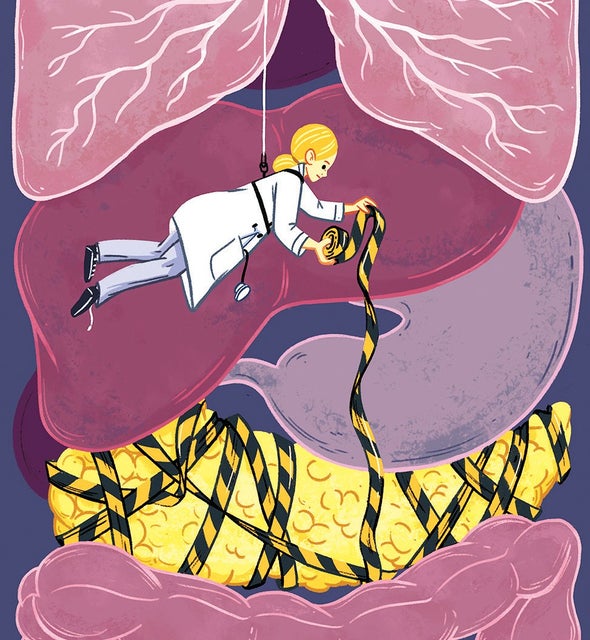We can all be grateful that pancreatic cancer is pretty rare—accounting for about 3 percent of all cancers. Its toll, however, is another story. Five years ago it was the fourth-leading cause of cancer deaths in the U.S. Today it's number three and expected to soon overtake colon cancer for the number-two spot, right behind lung cancer. Even more frightening, this lethal condition is becoming more common. In the U.S., its incidence has crept upward by about 0.5 percent annually for more than a decade. France, Japan and Taiwan have all reported rapid jumps.
What's behind these trends? There are multiple intersecting factors at work. The rising rank in mortality is, in some ways, a good thing; it reflects advances in battling other malignancies. Better screening and treatment have meant that patients with other types of cancer—particularly breast, prostate and colon cancer—are living long enough to die of something else. Unfortunately, innovations such as immunotherapy have not worked well for pancreatic cancer, so along with liver cancer, it is causing an outsize and growing portion of cancer-related deaths.
The expanding caseload is a little harder to explain. Some of it, too, reflects progress: refined ways of testing biopsied tissue and higher-resolution imaging have meant that mystery tumors that once couldn't be seen or were labeled “of unknown origin” can now be identified, and some turn out to be pancreatic. The aging of our population also contributes: it's pushing up the rates of many kinds of cancer. The longer we live, the more we accumulate genetic errors that can cause tumors and the less effective our DNA cleanup crew becomes. In the case of pancreatic cancer, more than three quarters of new patients are between 55 and 84 years old.
Other forces are at work as well. Smokers face more than twice a nonsmoker's risk of pancreatic cancer, and even though smoking has slumped in the U.S., there is a 30- to 40-year lag time before we see a corresponding drop in cancer rates. In theory, pancreatic cancer should be waning, thanks to the dramatic falloff in smoking that began in the 1970s. But sadly, a new villain on the block is taking up some of the slack: soaring rates of obesity and type 2 diabetes, which are also risk factors.
Oncologist Robert A. Wolff has been treating pancreatic cancer at the University of Texas MD Anderson Cancer Center for 20 years. “Since I've been practicing, I've seen a shift from smoking to obesity as the driver,” he says. “An average patient of mine has a body mass index between 30 and 35 [obesity is defined as 30 or more], has diabetes or prediabetes, is hypertensive and takes a lipid-lowering agent.” Toss in a history of smoking, and such patients, he says, “are just time bombs for pancreatic cancer.”
Obesity and type 2 diabetes raise the risk of many forms of cancer. Among the suspected reasons: chronic low-level inflammation, too much insulin, excess hormones and growth factors released by fat tissue, and metabolic abnormalities. Researchers are looking for early signs of pancreatic cancer in the blood or tissue of adults age 50 and older who were newly diagnosed with diabetes. Nearly 1 percent of such adults will develop the disease within three years, says Lola Rahib, a scientist at the Pancreatic Cancer Action Network, which supports the research. The challenge, she says, is to find biomarkers precise enough to avoid “costly and emotional” false positives and negatives. The quest for cancer blood tests—known as liquid biopsies—is one of the hottest areas in oncology, notes Otis Brawley, chief medical and scientific officer at the American Cancer Society, but there's a long way to go: “The tests reported so far have really terrible specificity.”
Even if blood tests could someday detect pancreatic cancer at an early stage, treatment would have to improve a lot for them to do much good. Unlike many cancers that are curable if detected early, pancreatic tumors are quick to metastasize. “The cells break away like a crumbling popcorn ball,” Brawley says. Still, some modest progress has been made. Five-year survival rates for pancreatic cancer have inched up from 6 to 9 percent in recent years.
Wolff believes that newer, precision medicine therapies will ultimately help his patients, particularly the 10 percent or so whose cancer is more driven by heredity than way of life. But the bigger message is prevention, he says: “It's thought that easily 30 percent of pancreatic cancer is preventable. Cutting back on obesity, better diets, more exercise, no smoking. What a concept!”


